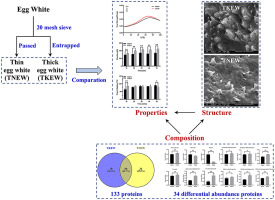当前位置:
X-MOL 学术
›
Food Hydrocoll.
›
论文详情
Our official English website, www.x-mol.net, welcomes your
feedback! (Note: you will need to create a separate account there.)
Underlying mechanism for the differences in heat-induced gel properties between thick egg whites and thin egg whites: Gel properties, structure and quantitative proteome analysis
Food Hydrocolloids ( IF 11.0 ) Pub Date : 2020-09-01 , DOI: 10.1016/j.foodhyd.2020.105873 Xin Liu , Jinqiu Wang , Qun Huang , Lei Cheng , Renyou Gan , Lili Liu , Di Wu , Hanmei Li , Lianxin Peng , Fang Geng
Food Hydrocolloids ( IF 11.0 ) Pub Date : 2020-09-01 , DOI: 10.1016/j.foodhyd.2020.105873 Xin Liu , Jinqiu Wang , Qun Huang , Lei Cheng , Renyou Gan , Lili Liu , Di Wu , Hanmei Li , Lianxin Peng , Fang Geng

|
Abstract Fresh chicken egg whites can be easily categorized into two types, including the colloid-like egg white and the solution-like egg white, which are called thick egg white (TKEW) and thin egg white (TNEW), respectively. In the present study, the heat-induced gel properties of TKEW and TNEW were systematically analyzed and compared. The results showed that TKEW (72.51 °C) had higher temperature of heat denaturation than TNEW (67.01 °C). The texture profile analysis demonstrated that the TKEW gel appeared soft and tough (lower hardness and higher cohesiveness), while the TNEW gel appeared hard and brittle (higher hardness and springiness, but lower cohesiveness). SEM images showed that the TKEW gel exhibited a “mesh structure” with “mountain-like” protrusions and micropores, while the TNEW gel exhibited a “block structure” with a dense section and “rope-head” protrusions. Quantitative proteomic analysis revealed that a higher content of ovotransferrin in TNEW might be the main reason for its lower temperature of thermal denaturation, and a higher content of ovomucin in TKEW might regulate the microstructure of the gel during heating and cause the differences in the gel texture properties. Overall, this study provides insights into the mechanism for the differences of heat-induced gel properties between TKEW and TNEW from the comprehensive “composition-structure-function” perspective, and can give guidance for the regulation of egg white gel properties during its application.
中文翻译:

厚蛋白和薄蛋白之间热诱导凝胶特性差异的潜在机制:凝胶特性、结构和定量蛋白质组分析
摘要 新鲜鸡蛋清可以很容易地分为胶体状蛋清和溶液状蛋清两种类型,分别称为浓蛋清(TKEW)和稀蛋清(TNEW)。在本研究中,系统地分析和比较了 TKEW 和 TNEW 的热诱导凝胶特性。结果表明,TKEW (72.51 °C) 的热变性温度高于 TNEW (67.01 °C)。质地剖面分析表明,TKEW 凝胶显得柔软而坚韧(较低的硬度和较高的内聚性),而 TNEW 凝胶则显得硬而脆(较高的硬度和弹性,但内聚性较低)。SEM 图像显示 TKEW 凝胶呈现“网状结构”,具有“山状”突起和微孔,而 TNEW 凝胶则表现出具有致密截面和“绳头”突起的“块状结构”。定量蛋白质组学分析表明,TNEW中较高含量的卵转铁蛋白可能是其热变性温度较低的主要原因,TKEW中较高含量的卵粘蛋白可能在加热过程中调节凝胶的微观结构并导致凝胶质地的差异特性。总体而言,本研究从“组成-结构-功能”的综合角度深入了解了TKEW和TNEW热致凝胶特性差异的机制,并可以为其应用过程中蛋清凝胶特性的调控提供指导。定量蛋白质组学分析表明,TNEW中较高含量的卵转铁蛋白可能是其热变性温度较低的主要原因,TKEW中较高含量的卵粘蛋白可能在加热过程中调节凝胶的微观结构并导致凝胶质地的差异特性。总体而言,本研究从“组成-结构-功能”的综合角度深入了解了TKEW和TNEW热致凝胶特性差异的机制,并可以为其应用过程中蛋清凝胶特性的调控提供指导。定量蛋白质组学分析表明,TNEW中较高含量的卵转铁蛋白可能是其热变性温度较低的主要原因,TKEW中较高含量的卵粘蛋白可能在加热过程中调节凝胶的微观结构并导致凝胶质地的差异特性。总体而言,本研究从“组成-结构-功能”的综合角度深入了解了TKEW和TNEW热致凝胶特性差异的机制,并可以为其应用过程中蛋清凝胶特性的调控提供指导。
更新日期:2020-09-01
中文翻译:

厚蛋白和薄蛋白之间热诱导凝胶特性差异的潜在机制:凝胶特性、结构和定量蛋白质组分析
摘要 新鲜鸡蛋清可以很容易地分为胶体状蛋清和溶液状蛋清两种类型,分别称为浓蛋清(TKEW)和稀蛋清(TNEW)。在本研究中,系统地分析和比较了 TKEW 和 TNEW 的热诱导凝胶特性。结果表明,TKEW (72.51 °C) 的热变性温度高于 TNEW (67.01 °C)。质地剖面分析表明,TKEW 凝胶显得柔软而坚韧(较低的硬度和较高的内聚性),而 TNEW 凝胶则显得硬而脆(较高的硬度和弹性,但内聚性较低)。SEM 图像显示 TKEW 凝胶呈现“网状结构”,具有“山状”突起和微孔,而 TNEW 凝胶则表现出具有致密截面和“绳头”突起的“块状结构”。定量蛋白质组学分析表明,TNEW中较高含量的卵转铁蛋白可能是其热变性温度较低的主要原因,TKEW中较高含量的卵粘蛋白可能在加热过程中调节凝胶的微观结构并导致凝胶质地的差异特性。总体而言,本研究从“组成-结构-功能”的综合角度深入了解了TKEW和TNEW热致凝胶特性差异的机制,并可以为其应用过程中蛋清凝胶特性的调控提供指导。定量蛋白质组学分析表明,TNEW中较高含量的卵转铁蛋白可能是其热变性温度较低的主要原因,TKEW中较高含量的卵粘蛋白可能在加热过程中调节凝胶的微观结构并导致凝胶质地的差异特性。总体而言,本研究从“组成-结构-功能”的综合角度深入了解了TKEW和TNEW热致凝胶特性差异的机制,并可以为其应用过程中蛋清凝胶特性的调控提供指导。定量蛋白质组学分析表明,TNEW中较高含量的卵转铁蛋白可能是其热变性温度较低的主要原因,TKEW中较高含量的卵粘蛋白可能在加热过程中调节凝胶的微观结构并导致凝胶质地的差异特性。总体而言,本研究从“组成-结构-功能”的综合角度深入了解了TKEW和TNEW热致凝胶特性差异的机制,并可以为其应用过程中蛋清凝胶特性的调控提供指导。









































 京公网安备 11010802027423号
京公网安备 11010802027423号